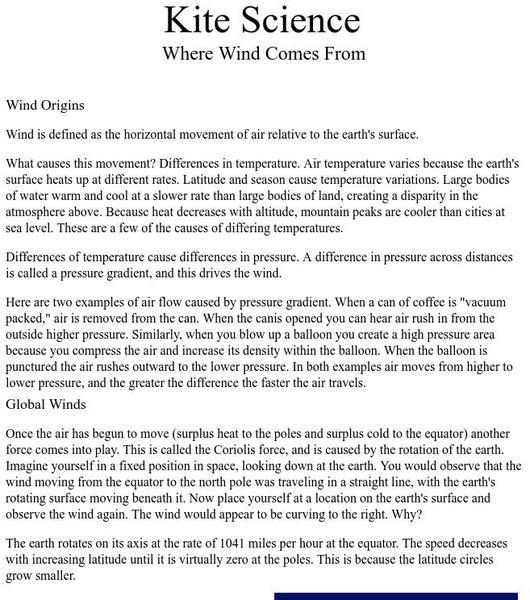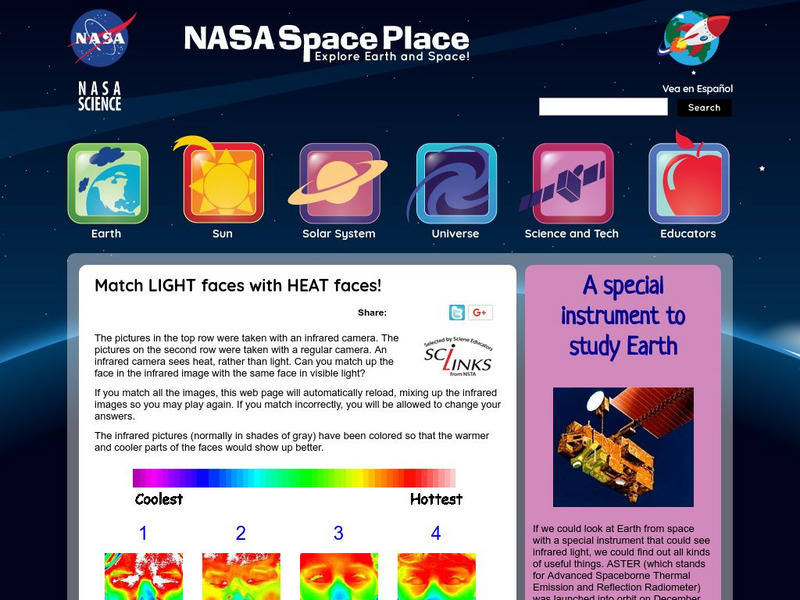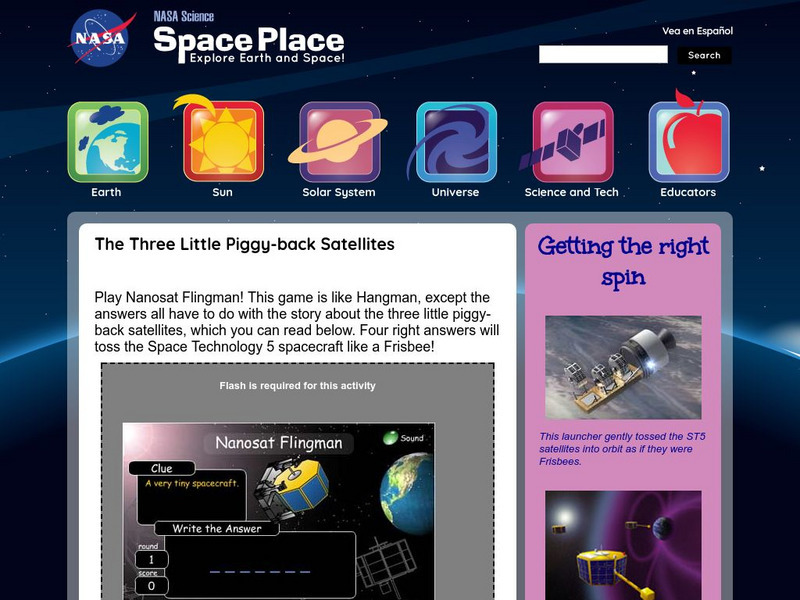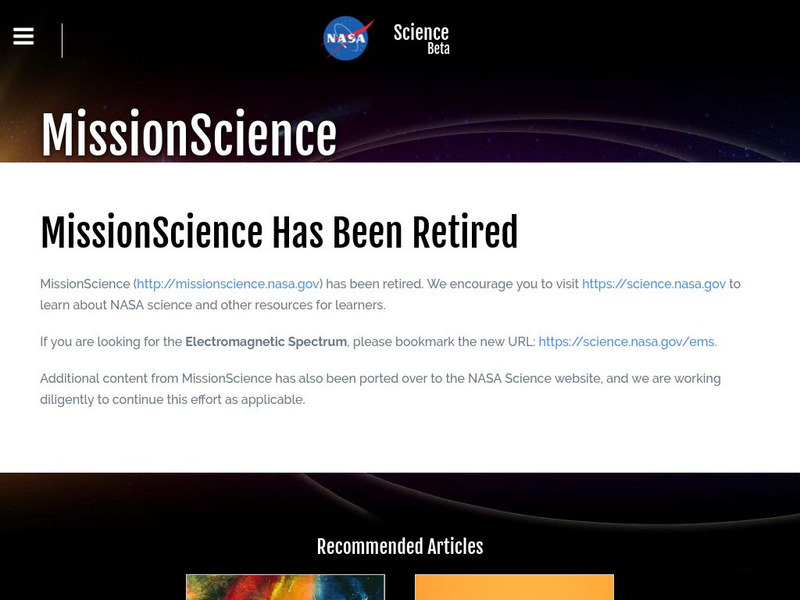Curated OER
Extraterrestrial Communication: Can We Talk to Anybody Out There?
Students examine the possibilities of communication with other living organisms within our solar system through research and hands on activities, as well as observing and analyzing teacher demonstrations.
Science Buddies
Science Buddies: A Change in the Winds: Studying Bernoulli's Principle
You can actually make objects come together by blowing air between them. This is a simple way of implementing Bernoulli's principle. Find out how wind changes air pressure to bring to objects together in this easy and fun science fair...
Science Buddies
Science Buddies: Why Do Birds Fly in a v Formation?
In this science fair project, the student will make a wind tunnel to test how the formation of birds in flight affects flight efficiency. Make the bird models out of Legos and have fun with this project. The Science Buddies project ideas...
US Senate
Us Senate Committee Commerce, Science and Transportation
The Senate Committee on Commerce, Science and Transportation has jurisdiction over several areas. Come and find out more about this powerful committee by checking out this resource.
NASA
Nasa: National Aeronautics and Space Administration
This is NASA's home page, with daily updates and links to the countless NASA sites. The multimedia gallery is of particular interest, containing a wealth of photos, videos, audio clips, and more.
Science Struck
Science Struck: 10 Nasa Inventions You Might Be Using Every Day
Many things invented by NASA are used in everyday life. Some of the most widely used inventions are described here.
Digital Public Library of America
Dpla: Race to the Moon
In 1955, the US and the USSR each announced plans to launch a satellite into orbit. Thus began the race to the moon. Throughout the 1960s and 1970s, the American space program and its new classes of astronauts achieved breakthroughs in...
National Women’s History Museum
National Women's History Museum: Breaking Through Gender Roles
Students will explore the women of NASA and identify and analyze their key contributions to the field of aeronautics.
NASA
Nasa Homepage
The official homepage of NASA, the United States' primary space exploration organization.
NASA
Nasa: Tests Versus Time in the Race for Space
This NASA site offers a good description of the ongoing space race during the Kennedy administration, discussing the "nip and tuck" of the Soviet-U.S. race. Also includes a description of Kennedy's new special assistant for science and...
PBS
Pbs Learning Media: Bringing the Universe to America's Classrooms
WGBH in collaboration with NASA presents digital media resources you can use to teach topics in K-12 Earth and Space Science. These free resources are organized into four grade bands. Each resource emphasizes engaging students in...
NASA
Nasa Space Place: Amazing Facts
This site from the National Aeronautics and Space Administration asks the question, how can you hit a soccer goal on the Moon from Earth? Find an answer to this question as well as many more answered by Dr. Marc.
Other
Kites as Education: Wind Origins
This "kite science" site offers information on wind and the atmospheric conditions that cause it. From "Principles of Aeronautics."
NASA
Nasa: The Space Place: Match Light Faces With Heat Faces
This site from the National Aeronautics and Space Administration provides information on the subject. "An infrared camera sees heat, rather than light. Can you match up the face in the infrared image with the same face in visible light?"
Curated OER
National Park Service: Dunes and Dreams: White Sands National Monument [Pdf]
Kennedy's economic stimulus plan was a package that would "galvanize science, industry, and government." Although written by NPS with White Sands as the focus, it contains a good description of the impact of the space program.
NASA
Nasa: The Space Place: Keck Interferometer
This site from the National Aeronautics and Space Administration provides the opportunity to solve a crossword and learn about the world's biggest telescopes.
Khan Academy
Khan Academy: The Start of the Space Race
Looks at the USSR's launch of Sputnik and the galvanizing effect it had on America's motivation to fund aerospace research. NASA was soon formed and more funding was put in place for public education in the sciences and math.
NASA
Nasa: The Space Place: The Three Little Piggy Back Satellites
This site from the National Aeronautics and Space Administration allows one to read the "Three Little Piggy-back Satellites," and then play the Nanosat Flingman game. [Requires Shockwave]
Space Telescope Science Institute
Overview of the Hubble Space Telescope
This site gives an overview of the Hubble Space Telescope program. It also gives details about the previous and current science instruments used in the program, and information about the mission operations and observations.
NASA
Nasa: Mysteries of the Sun
Learn about the study of the Sun's influence on the solar system called Heliophysics. This site contains videos on topics like Space Weather, Solar Variability, the Heliosphere, Earth's Magnetosphere, and the Earth's Upper Atmosphere.
NASA
Nasa: Tour of the Electromagnetic Spectrum: Visible Light
Visible light waves are the only electromagnetic waves we can see. We see these waves as the colors of the rainbow. Each color has a different wavelength. Red has the longest wavelength and violet has the shortest wavelength. When all...
My Hero Project
My Hero: Jules Verne
Jules Verne, who wrote over 80 books during his lifetime, is best known for his "20,000 Leagues Under the Sea." This article includes several images and related links.
Exploratorium
Exploratorium: Third From the Sun
This site offers a short history of the evolution of the space program and man's quest for more revealing and detailed pictures of the earth.
Smithsonian Institution
National Air and Space Museum: The Black Wings Story
This online story tells of how African Americans overcame enormous obstacles to break into aviation. Besides tracing the story there are primary sources, classroom activities, and teaching resources are included.
















